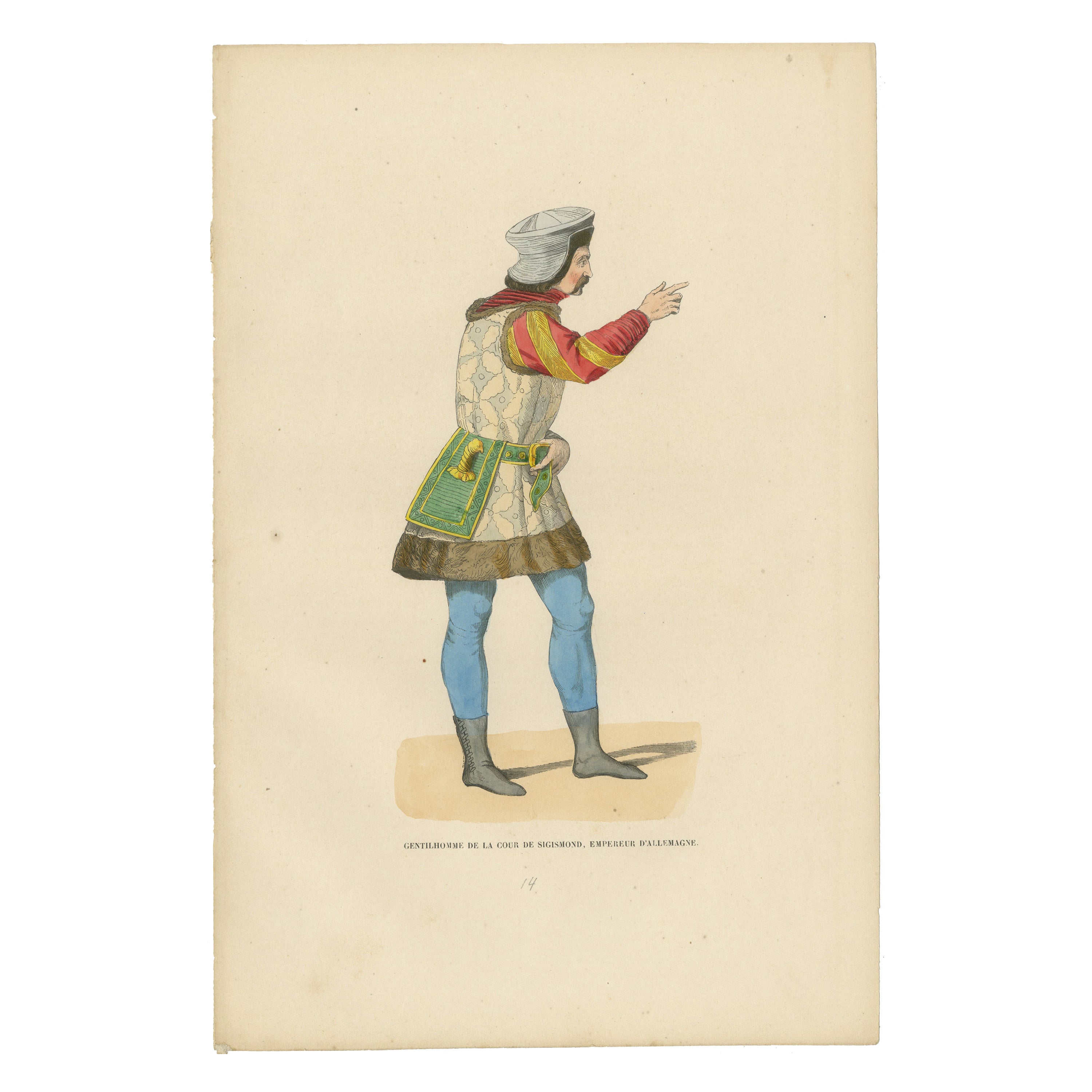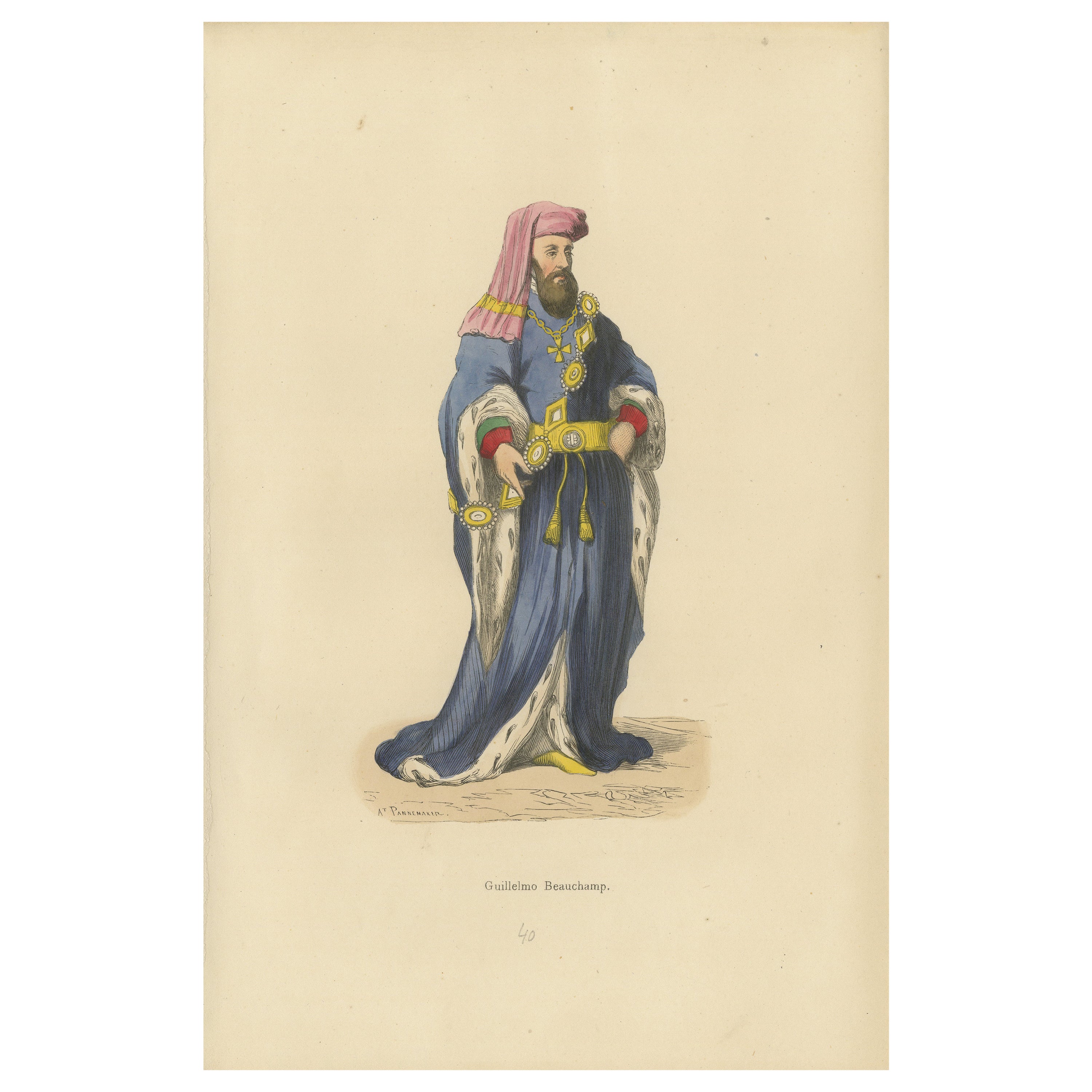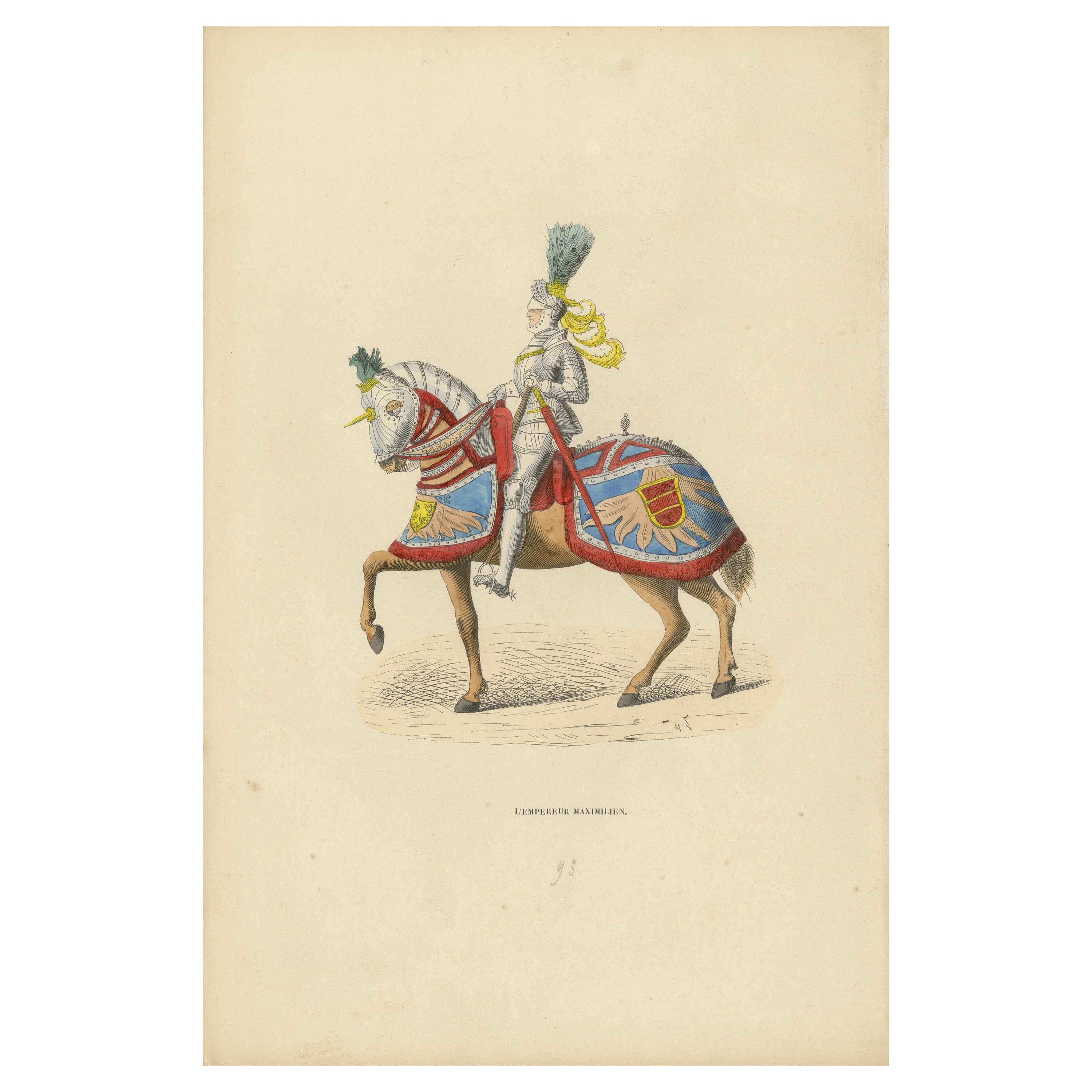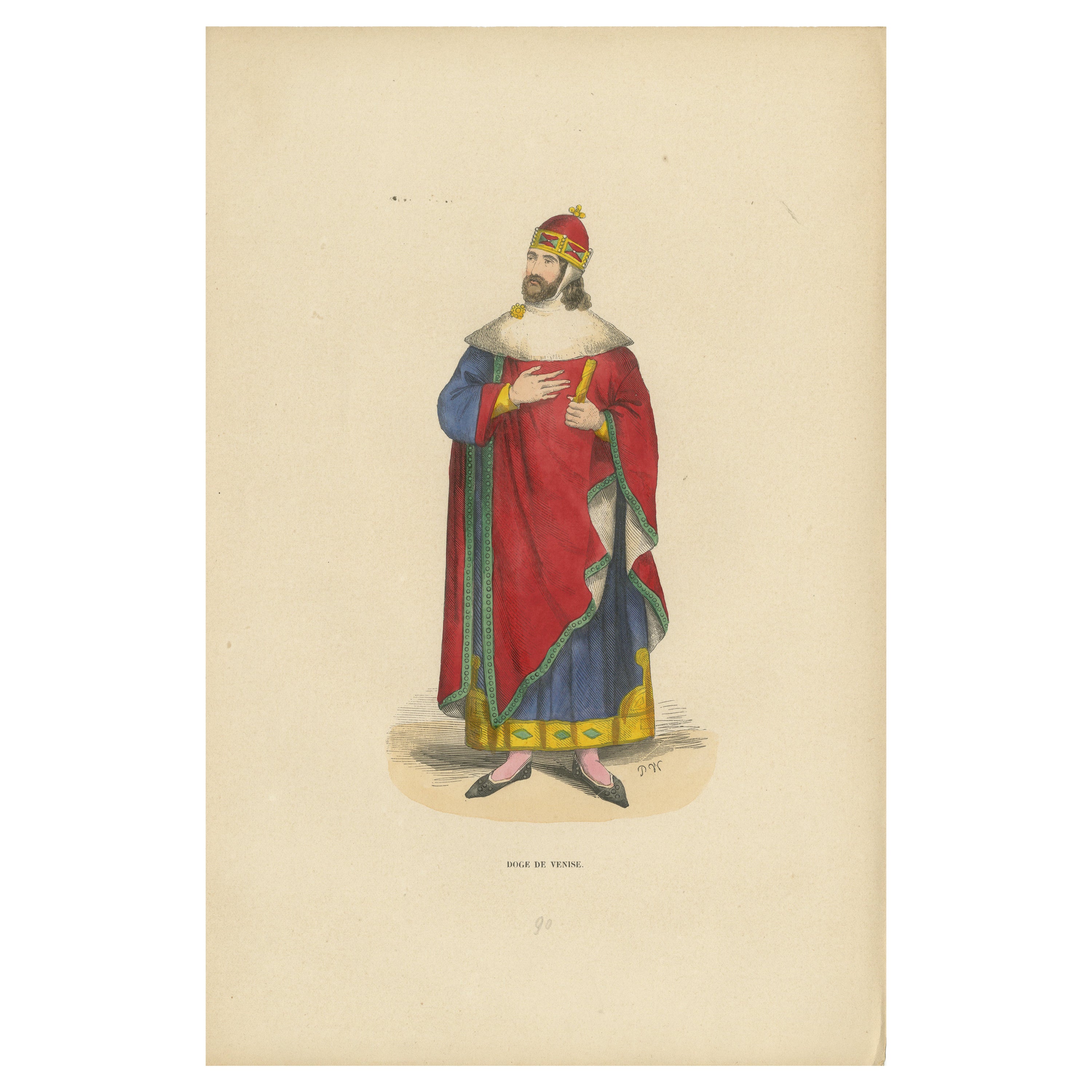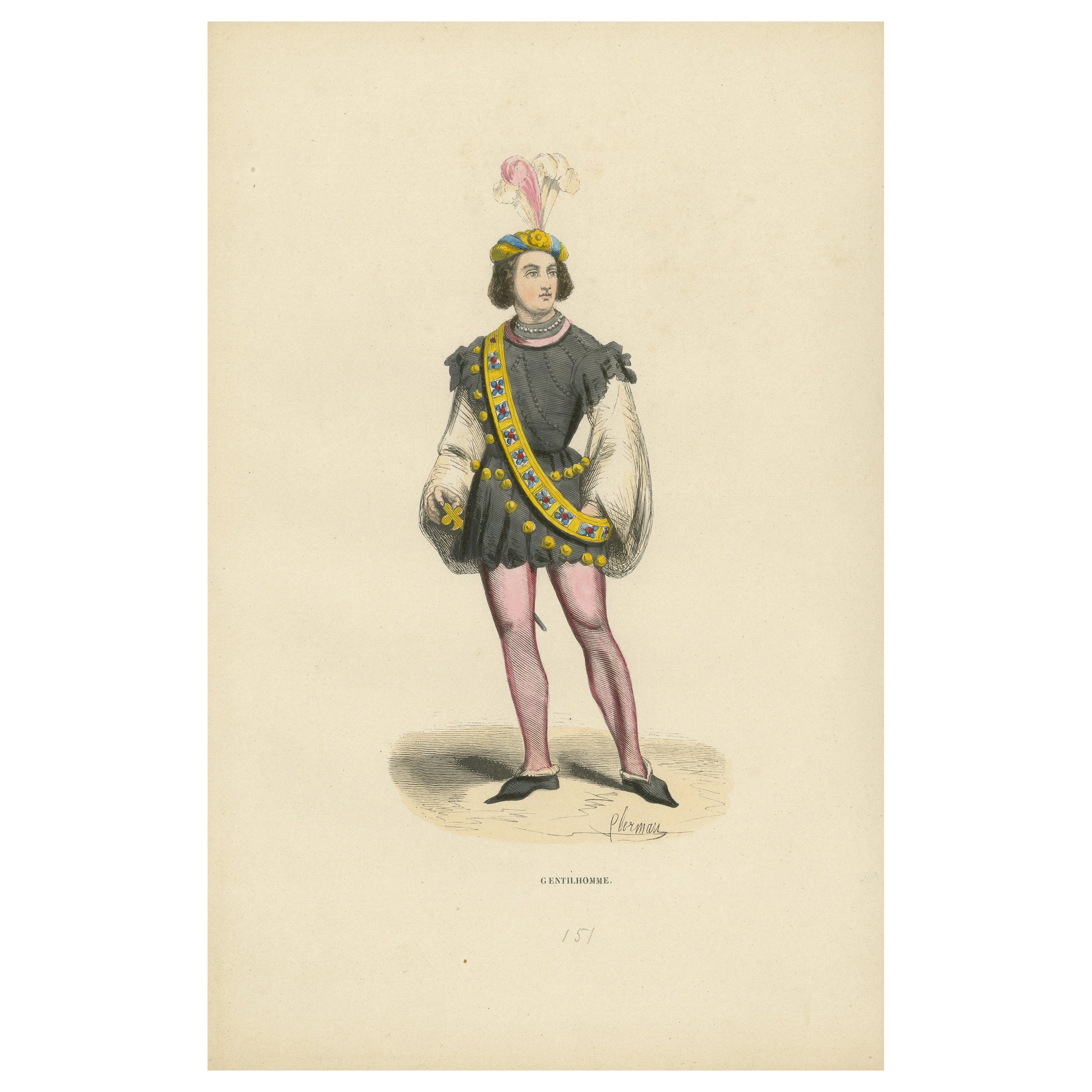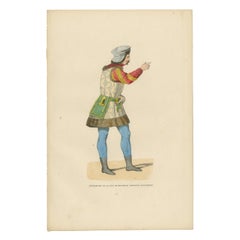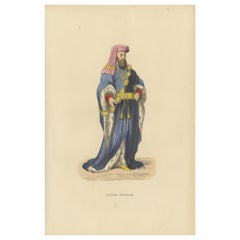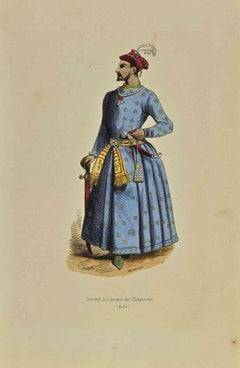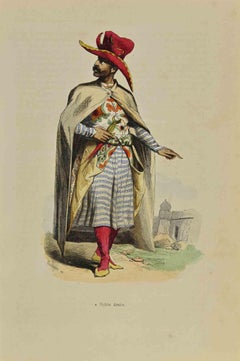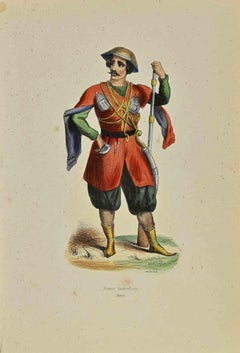Items Similar to Imperial Majesty: Emperor Frederick III in 'Costume du Moyen Âge, 1847
Want more images or videos?
Request additional images or videos from the seller
1 of 6
Imperial Majesty: Emperor Frederick III in 'Costume du Moyen Âge, 1847
$132.32
$165.4020% Off
£99.18
£123.9820% Off
€112
€14020% Off
CA$181.79
CA$227.2420% Off
A$202.95
A$253.6920% Off
CHF 106.34
CHF 132.9320% Off
MX$2,484.31
MX$3,105.3920% Off
NOK 1,350.56
NOK 1,688.1920% Off
SEK 1,273.40
SEK 1,591.7520% Off
DKK 852.58
DKK 1,065.7320% Off
Shipping
Retrieving quote...The 1stDibs Promise:
Authenticity Guarantee,
Money-Back Guarantee,
24-Hour Cancellation
About the Item
Title: "Imperial Majesty: Emperor Frederick III in 'Costume du Moyen Âge'"
Description: This lithograph from the "Costume du Moyen Âge" collection, printed in 1847, depicts Emperor Frederick III, ruler of the Holy Roman Empire in the 15th century. The emperor is shown in profile, in a stately pose that conveys his imperial authority. He is dressed in an elaborate ceremonial robe, richly decorated with detailed patterns, likely signifying his imperial power and the grandeur of his office.
The robe is a vibrant yellow with intricate embellishments, which may symbolize the empire over which he reigned. It is trimmed with a dark band at the hem, perhaps velvet or another luxurious material, indicating the wealth and splendor associated with his status. Underneath, he wears a tunic in a contrasting blue, with sleeves that match the decorative pattern of his robe.
On his head, Frederick III wears a mitre-shaped hat, embellished with what appears to be heraldic symbols, further emphasizing his role as a monarch. His red stockings and yellow pointed shoes are consistent with the fashion of the time for men of high status.
The emperor's facial expression is serious and contemplative, befitting a ruler known for his political acumen and the long duration of his reign. His right hand is extended, possibly in a gesture of benediction or command.
This image serves not only as a study in the clothing of a medieval emperor but also as a representation of the imperial majesty and the role that fashion played in the visual language of power during the Middle Ages. The lithograph is a window into the past, providing a visual account of the splendor of imperial regalia.
The colors have a nice glow over them. Historically, egg whites, known as glair, and sometimes egg yolk were indeed used in illumination and painting, particularly in manuscripts, to give colors a brighter appearance and to add a sheen or gloss to the work. This technique was quite common during the Middle Ages and into the Renaissance.
Egg whites can be applied as a varnish over pigments to enhance their brightness and to protect the colors. This application could make the colors appear more vivid and also add a slight glossy sheen to the surface of the image.
Egg yolk, on the other hand, was commonly used as a binding agent in paint. It forms the basis of tempera paint, a medium that was widely used before the advent of oil painting. Egg yolk helps to create a durable and long-lasting color that adheres well to various surfaces.
In the context of the print from 1847, it's less likely that egg whites or yolks were used directly on the print, as by that time, commercial printing processes would have been more advanced and less reliant on such manual methods. However, if this print is a representation of an earlier style or is meant to mimic the appearance of hand-painted manuscripts, the original artists might have employed techniques or materials that gave a similar effect to those achieved with egg-based binders and varnishes.
- Dimensions:Height: 10.63 in (27 cm)Width: 7.09 in (18 cm)Depth: 0 in (0.02 mm)
- Materials and Techniques:
- Period:
- Date of Manufacture:1847
- Condition:Good. Overal light toning and light soiling but the image itself clean and hand-colored almost 200 years ago and still in expliciet colors. Aged paper with typically warm, yellowish-brown hue, mostly around the edges. Study the images carefully.
- Seller Location:Langweer, NL
- Reference Number:Seller: BG-13635-1251stDibs: LU3054337927762
About the Seller
5.0
Recognized Seller
These prestigious sellers are industry leaders and represent the highest echelon for item quality and design.
Platinum Seller
Premium sellers with a 4.7+ rating and 24-hour response times
Established in 2009
1stDibs seller since 2017
2,511 sales on 1stDibs
Typical response time: <1 hour
- ShippingRetrieving quote...Shipping from: Langweer, Netherlands
- Return Policy
Authenticity Guarantee
In the unlikely event there’s an issue with an item’s authenticity, contact us within 1 year for a full refund. DetailsMoney-Back Guarantee
If your item is not as described, is damaged in transit, or does not arrive, contact us within 7 days for a full refund. Details24-Hour Cancellation
You have a 24-hour grace period in which to reconsider your purchase, with no questions asked.Vetted Professional Sellers
Our world-class sellers must adhere to strict standards for service and quality, maintaining the integrity of our listings.Price-Match Guarantee
If you find that a seller listed the same item for a lower price elsewhere, we’ll match it.Trusted Global Delivery
Our best-in-class carrier network provides specialized shipping options worldwide, including custom delivery.More From This Seller
View AllCourtly Splendor: A Nobleman at Emperor Sigismund's Court, 1847
Located in Langweer, NL
The image depicts a man identified as a "Gentilhomme de la cour de Sigismond, empereur d'Allemagne," which translates to "Gentleman of the court of Sigismund, Emperor of Germany."
This individual is portrayed in a profile stance, dressed in attire that is indicative of the high-status courtiers during the time of Emperor Sigismund, who reigned in the early 15th century. He is wearing a turban-like headgear, which reflects the influence of Eastern fashion on European court attire, possibly due to the Ottoman influence or the general exchange of culture during the Crusades and subsequent interactions.
His doublet is richly patterned and he has puffed sleeves in red, which were fashionable among the nobility during the period. The garment is accented with a decorative belt that holds what appears to be a purse or a pouch. He also sports tight blue hose and pointed shoes, which complete the ensemble typical of a nobleman or a high-ranking court official in the Holy Roman Empire.
Egg whites can be applied as a varnish over pigments to enhance their brightness and to protect the colors. This application could make the colors appear more vivid and also add a slight glossy sheen to the surface of the image.
Egg yolk, on the other hand, was commonly used as a binding agent in paint. It forms the basis of tempera paint, a medium that was widely used before the advent of oil painting. Egg yolk helps to create a durable and long-lasting color that adheres well to various surfaces.
In the context of the print from 1847, it's less likely that egg whites or yolks were used directly on the print, as by that time, commercial printing processes would have been more advanced and less reliant on such manual methods. However, if this print is a representation of an earlier style or is meant to mimic the appearance of hand-painted manuscripts...
Category
Antique 1840s Prints
Materials
Paper
$151 Sale Price
20% Off
Noble Bearing: A German Gentleman in Medieval Attire, 1847
Located in Langweer, NL
Title: "Noble Bearing: A German Gentleman in Medieval Attire from 'Costume du Moyen Âge'"
Description: This 1847 lithograph from the esteemed collection "Costume du Moyen Âge" showc...
Category
Antique 1840s Prints
Materials
Paper
$170 Sale Price
20% Off
William de Beauchamp in Noble Attire in An Original Handcolored Lithograph, 1847
Located in Langweer, NL
This original antique print portrays a medieval nobleman, identified as "Guillelmo Beauchamp," which may refer to William de Beauchamp, a prominent figure in English history. The nob...
Category
Antique 1840s Prints
Materials
Paper
$151 Sale Price
20% Off
Imperial Splendor: Emperor Maximilian on Parade, 1847
Located in Langweer, NL
Title: "Regal Bearing: Emperor Maximilian on Parade"
Description: This historical illustration depicts Emperor Maximilian arrayed in full regalia, mounted on a proud and well-groome...
Category
Antique 1840s Prints
Materials
Paper
$245 Sale Price
20% Off
Venetian Dignity: The Doge in Contemplation, Engraving of 1847
Located in Langweer, NL
Title: "Venetian Dignity: The Doge in Contemplation"
Description: This handcolored historical print captures a Doge of Venice in a moment of solemn reflection. The Doge, as the chie...
Category
Antique 1840s Prints
Materials
Paper
$132 Sale Price
20% Off
The Gallant Courtier: A Nobleman's Fashion in 'Costume du Moyen Âge, 1847
Located in Langweer, NL
Title: "The Gallant Courtier: A Nobleman's Fashion in 'Costume du Moyen Âge'"
Description: This 1847 lithograph from the "Costume du Moyen Âge" collection depicts a nobleman dressed...
Category
Antique 1840s Prints
Materials
Paper
$132 Sale Price
20% Off
You May Also Like
General of the Emperor’s Guards - Lithograph by Auguste Wahlen - 1844
Located in Roma, IT
General of the Emperor’s Guards is a lithograph made by Auguste Wahlen in 1844.
Hand colored.
Good condition.
At the center of the artwork is the original title "General des garde...
Category
1840s Modern Figurative Prints
Materials
Lithograph
Noble Arab - Lithograph by Auguste Wahlen - 1844
Located in Roma, IT
Noble Arab is a lithograph made by Auguste Wahlen in 1844.
Hand colored.
Good condition.
At the center of the artwork is the original title "Noble Arabe".
The work is part of Sui...
Category
1840s Modern Figurative Prints
Materials
Lithograph
Persian Noble Man - Lithograph by Auguste Wahlen - 1844
Located in Roma, IT
Persian Nobleman is a lithograph made by Auguste Wahlen in 1844.
Hand colored.
Good condition.
At the center of the artwork is the original title "Noble Persan".
The work is part...
Category
1840s Modern Figurative Prints
Materials
Lithograph
Imerethian Prince - Lithograph by Auguste Wahlen - 1844
Located in Roma, IT
Imerethian Prince is a lithograph made by Auguste Wahlen in 1844.
Hand colored.
Good condition.
At the center of the artwork is the original title "Imerethian Prince".
The work i...
Category
1840s Modern Figurative Prints
Materials
Lithograph
Sultan Selim II - Original Lithograph - 1849s
Located in Roma, IT
Sultano Selim II is an original artwork realized by an Unknown artist in 1849.
Beautiful lithograph hand-watercolored on paper.
Good conditions. Titled on the bottom center. Delfin...
Category
1840s Modern Figurative Prints
Materials
Lithograph
Le Impératrice Eugénie Lithograph, c.1850s
Located in Savannah, GA
A large hand-colored lithograph entitled “Le Impératrice, Compiegne,” after the painting by Jean Victor Adam (1801-1866), circa 1850s. Depicted is the Empress Eugénie de Montijo, wi...
Category
Antique Mid-19th Century French Other Prints
Materials
Glass, Wood, Paper
More Ways To Browse
Velvet Embellished Dress
Imperial Robe
Antique Silver Boxes Repousse
Antique Storm Glass
Antique Thimbles
Antique Victorian Grandfather Clock
Antique Wooden Swan
Art Deco Bed Frame Queen
Art Deco Buffet Mirror
Art Deco Desk Statue
Art Deco Full Bed
Art Deco Glass Shelving
Astronomical Clock
Baker Dining Buffet
Baker Neoclassical Dining
Baker New World Collection
Baroque Headboard
Bear Bookends
